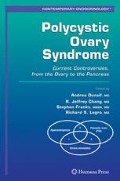Summary
Neurologic and psychiatric disorders offer a unique opportunity to study the polycystic ovary syndrome (PCOS) phenotype. Menstrual disorders are frequently associated with the presentation of epilepsy and bipolar disorder, and common factors and pathways may be involved. Some treatments of these conditions, for instance valproate, are thought to bring out stigmata of PCOS in susceptible individuals. The prevalence of PCOS appears higher in women with epilepsy and bipolar disorder. In addition, studies suggest that anti-epileptic drugs (AEDs), particularly valproate, may heighten a woman’s risk for developing PCOS, especially with concomitant weight gain. Preliminary evidence suggests that oral contraceptives may be protective in certain instances. Further prospective studies are needed to better quantify the effects of treatment as well as the underlying disorder itself on development of the PCOS phenotype.
Access this chapter
Tax calculation will be finalised at checkout
Purchases are for personal use only
Preview
Unable to display preview. Download preview PDF.
References
Sam S, Dunaif A. Polycystic ovary syndrome: syndrome XX? Trends Endocrinol Metab 2003;14(8):365–70.
Legro RS, Spielman R, Urbanek M, Driscoll D, Strauss JFr, Dunaif A. Phenotype and genotype in polycystic ovary syndrome. Recent Prog in Horm Res 1998; 53:217–56.
Rotterdam ESHRE/ASRM-Sponsored PCOS Consensus Workshop Group. Revised 2003 consensus on diagnostic criteria and long-term health risks related to polycystic ovary syndrome. Fertil Steril 2004;81(1):19–25.
Rotterdam ESHRE/ASRM-Sponsored PCOS Consensus Workshop Group. Revised 2003 consensus on diagnostic criteria and long-term health risks related to polycystic ovary syndrome (PCOS). Hum Reprod 2004;19(1):41–7.
Wallace H, Shorvon S, Tallis R. Age-specific incidence and prevalence rates of treated epilepsy in an unselected population of 2,052,922 and age-specific fertility rates of women with epilepsy. Lancet 1998;352(9145):1970–3.
Herzog AG, Coleman AE, Jacobs AR, et al. Interictal EEG discharges, reproductive hormones, and menstrual disorders in epilepsy. Ann Neurol 2003;54(5):625–37.
Herzog AG, Friedman MN. Menstrual cycle interval and ovulation in women with localization-related epilepsy. Neurology 2001;57(11):2133–5.
Svalheim S, Tauboll E, Bjornenak T, et al. Do women with epilepsy have increased frequency of menstrual disturbances? Seizure 2003;12(8):529–33.
Morrell MJ, Giudice L, Flynn KL, et al. Predictors of ovulatory failure in women with epilepsy. Ann Neurol 2002;52(6):704–11.
Herzog AG. Menstrual disorders in women with epilepsy. Neurology 2006;66(6 Suppl 3):S23–8.
Herzog AG, Seibel MM, Schomer DL, Vaitukaitis JL, Geschwind N. Reproductive endocrine disorders in women with partial seizures of temporal lobe origin. Arch Neurol 1986;43(4):341–6.
Drislane FW, Coleman AE, Schomer DL, et al. Altered pulsatile secretion of luteinizing hormone in women with epilepsy. Neurology 1994;44(2):306–10.
Herzog AG. Intermittent progesterone therapy and frequency of complex partial seizures in women with menstrual disorders. Neurology 1986;36(12):1607–10.
Isojarvi JI, Laatikainen TJ, Pakarinen AJ, Juntunen KT, Myllyla VV. Polycystic ovaries and hyperandrogenism in women taking valproate for epilepsy. N Engl J Med 1993;329:1383–8.
Isojarvi JI, Laatikainen TJ, Pakarinen AJ, Juntunen KT, Myllyla VV. Menstrual disorders in women with epilepsy receiving carbamazepine. Epilepsia 1995;36(7):676–81.
Zawadski JK, Dunaif A. Diagnostic criteria for polycystic ovary syndrome; towards a rational approach. In: A D, JR G, F H, GR M, eds. Polycystic Ovary Syndrome. Boston, MA: Blackwell Scientific; 1992:377–84.
Isojarvi JI, Rattya J, Myllyla VV, et al. Valproate, lamotrigine, and insulin-mediated risks in women with epilepsy. Ann Neurol 1998;43:446–51.
Morrell MJ, Isojarvi J, Taylor AE, et al. Higher androgens and weight gain with valproate compared with lamotrigine for epilepsy. Epilepsy Res 2003;54(2–3):189–99.
Luef G, Abraham I, Haslinger M, et al. Polycystic ovaries, obesity and insulin resistance in women with epilepsy. A comparative study of carbamazepine and valproic acid in 105 women. J Neurol 2002;249(7):835–41.
Luef G, Abraham I, Trinka E, et al. Hyperandrogenism, postprandial hyperinsulinism and the risk of PCOS in a cross sectional study of women with epilepsy treated with valproate. Epilepsy Res 2002;48(1–2):91–102.
Matsunaga H, Sarai M. Elevated serum LH and androgens in affective disorder related to the menstrual cycle: with reference to polycystic ovary syndrome. Jpn J Psychiatry Neurol 1993;47: 825–42.
Rasgon NL, Altshuler LL, Gudeman D, et al. Medication status and polycystic ovary syndrome in women with bipolar disorder: a preliminary report. J Clin Psychiatry 2000;61(3):173–8.
O’Donovan C, Kusumakar V, Graves GR, Bird DC. Menstrual abnormalities and polycystic ovary syndrome in women taking valproate for bipolar mood disorder. J Clin Psychiatry 2002;63(4):322–30.
Akdeniz F, Taneli F, Noyan A, Yuncu Z, Vahip S. Valproate-associated reproductive and metabolic abnormalities: are epileptic women at greater risk than bipolar women? Prog Neuropsychopharmacol Biol Psychiatry 2003;27(1):115–21.
Joffe H, Cohen LS, Suppes T, et al. Valproate is associated with new-onset oligoamenorrhea with hyperandrogenism in women with bipolar disorder. Biol Psychiatry 2006;59(11):1078–86.
Betts T, Yarrow H, Dutton N, Greenhill L, Rolfe T. A study of anticonvulsant medication on ovarian function in a group of women with epilepsy who have only ever taken one anticonvulsant compared with a group of women without epilepsy. Seizure 2003;12(6):323–9.
Soares JC. Valproate treatment and the risk of hyperandrogenism and polycystic ovaries. Bipolar Disorders 2000;2(1):37–41.
Tauboll E, Gregoraszczuk EL, Kolodziej A, Kajta M, Ropstad E. Valproate inhibits the conversion of testosterone to estradiol and acts as an apoptotic agent in growing porcine ovarian follicular cells. Epilepsia 2003;44(8):1014–21.
Popovic V, Spremovic S. The effect of sodium valproate on luteinizing hormone secretion in women with polycystic ovary disease. J Endocrinol Invest 1995;18:104–8.
Popovic V, Spremovic-Radjenovic S, Eric-Marinkovic J, Grossman A. Effect of sodium valproate on luteinizing hormone secretion in pre- and postmenopausal women and its modulation by naloxone infusion. J Clin Endocrinol Metab 1996;81(7):2520–4.
Nelson-DeGrave VL, Wickenheisser JK, Cockrell JE, et al. Valproate potentiates androgen biosynthesis in human ovarian theca cells. Endocrinology 2004;145(2):799–808.
Fluck CE, Yaworsky DC, Miller WL. Effects of anticonvulsants on human p450c17 (17alpha-hydroxylase/17,20 lyase) and 3beta-hydroxysteroid dehydrogenase type 2. Epilepsia 2005;46(3): 444–8.
Editor information
Editors and Affiliations
Rights and permissions
Copyright information
© 2008 Humana Press
About this chapter
Cite this chapter
Legro, R.S., Winans, E.A. (2008). Acquired Polycystic Ovary Syndrome. In: Dunaif, A., Chang, R.J., Franks, S., Legro, R.S. (eds) Polycystic Ovary Syndrome. Contemporary Endocrinology. Humana Press. https://doi.org/10.1007/978-1-59745-108-6_9
Download citation
DOI: https://doi.org/10.1007/978-1-59745-108-6_9
Publisher Name: Humana Press
Print ISBN: 978-1-58829-831-7
Online ISBN: 978-1-59745-108-6
eBook Packages: MedicineMedicine (R0)

